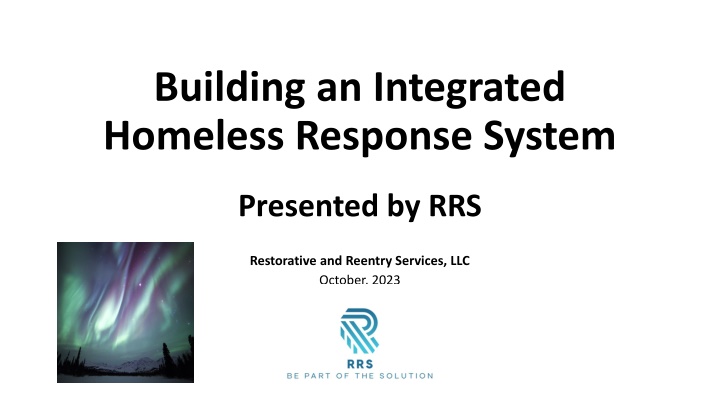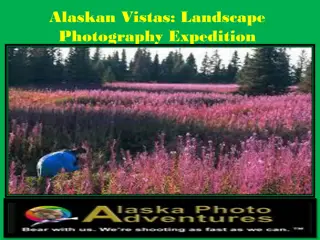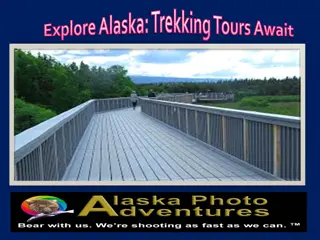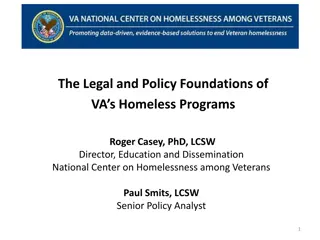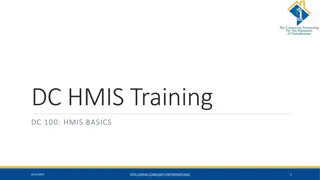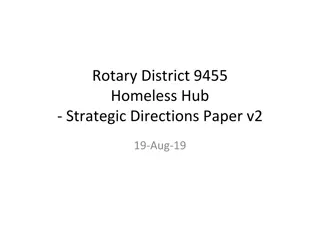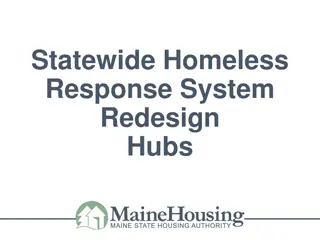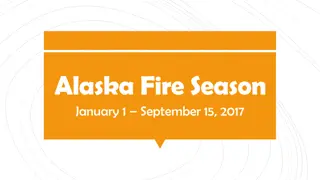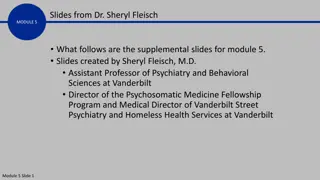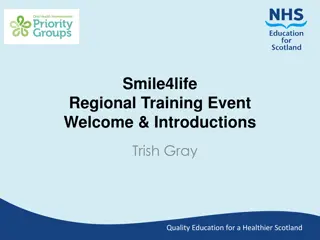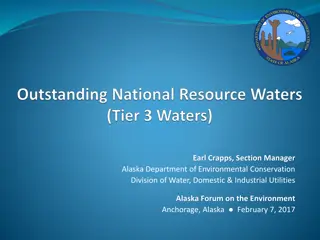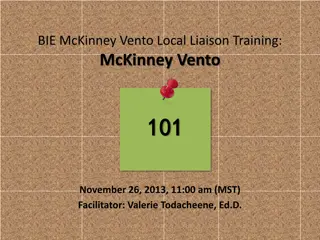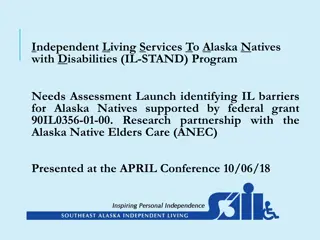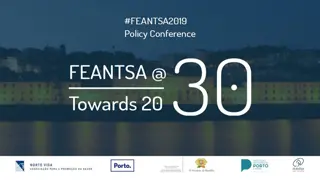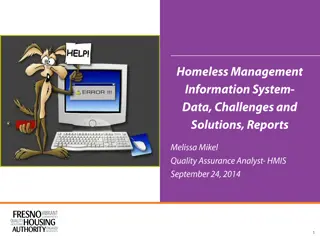Building an Integrated Homeless Response System in Alaska
An integrated homeless response system presented by RRS Restorative and Reentry Services focuses on ending homelessness in Alaska through proactive solutions and collaboration. The mission, vision, and values of RRS emphasize access to safe and sustainable housing, stakeholder network building, servant-leader management, client-centered approach, and statewide collaboration.
Download Presentation

Please find below an Image/Link to download the presentation.
The content on the website is provided AS IS for your information and personal use only. It may not be sold, licensed, or shared on other websites without obtaining consent from the author.If you encounter any issues during the download, it is possible that the publisher has removed the file from their server.
You are allowed to download the files provided on this website for personal or commercial use, subject to the condition that they are used lawfully. All files are the property of their respective owners.
The content on the website is provided AS IS for your information and personal use only. It may not be sold, licensed, or shared on other websites without obtaining consent from the author.
E N D
Presentation Transcript
Building an Integrated Homeless Response System Presented by RRS Restorative and Reentry Services, LLC October, 2023
Why it Matters An integrated homeless response system will put Alaska on the path to end homelessness. We need solutions that are proactive. Supporting RRS in its mission and vision to do the work needed will help us build stronger communities and a stronger state. In Alaska we take care of one another, and now is the time to be bold and come together to solve this complicated challenge. 2
To end homelessness in Alaska through an integrated and collaborative system of support and housing, providing comprehensive services and real-time solutions. Our Mission 4
An Alaska where every individual has access to safe, supportive, and sustainable housing and services that match individual need. A network of stakeholders that work together to support this vision and actualize it. Our Vision 5
Servant-Leader Management: We lead with integrity, collaboration, and honest communication. Client-Centered Approach: We prioritize individuals over program-centric solutions, and respect that all have agency (the power to control one s life). Accountability: We transparently measure and analyze. Real-Time Implementation of Solutions: We adapt quickly to address challenges. Openness to Innovation: We embrace new solutions and learn from our experiences. Statewide Collaboration: We recognize homelessness as a statewide issue and endorse a coordinated statewide response. We Care: Our facilitation of system change to serve people experiencing homelessness is not just a job. We are passionate about our work. Our Values 6
The Homeless System 7
A Homeless Response is NOT a Linear Path Permanent Sustainable Housing + or - support services Transitional Housing Basic Low Barrier Shelter Survival Mode -Street/camping/couch-surfing 8
An Integrated Homeless Response Recognizes the Complexity of People s Lives and Moves Between Survival, Stabilization and Sustainability Congregate Low Barrier Shelter- A Safe Place to Rest Interim Supportive Housing Sustainable Permanent Housing Survival Mode More Stable Shelter Moving to Stabilization to Purposefulness- Interim Supportive Housing Hotel Rooms Shelter De-compression Beds Pallet Shelter Communities Dignity Villages Street Camping Couch Surfing Ongoing Supportive Services if Needed 9
An Integrated Homeless Response Matches Client Need with Level of Service Examples: Permanent Affordable Housing and Supportive Housing like Lakeshore Inn, Golden Lion, Cook Inlet Housing, NeighborWorks Permanent Housing (Ongoing Support if Needed) Sustainability Examples: Permanent Supportive Housing like Guest House, Barrett Inn, Golden Lion, RuralCap 325 3rd Avenue, Sitka Place and Karluk Manor, NWA SBRA and TBRA, Assisted Living Facilities Purpose Driven Housing The Elevator Goes Up and Down Treatment Programs/Assisted Living Facilities/Vocational Training Examples: Transitional Housing & Interim Supportive Housing like Henry House, Streets to Success, Clare House, McKinnell, Covenant Rights of Passage, New Life Development, Safe Harbor Muldoon, Home For Good, Pallet Shelter Communities Stabilization Stabilization Housing- Interim Supportive Housing (Pallet Shelters, Modular Units, Co-Living, Tiny Homes, Rooming Houses) Examples: Brother Francis Shelter, Anchorage Rescue Mission, CSS Complex Care, Downtown Hope Center, Covenant House, AWAIC, Cold weather shelter, Low barrier shelter, Sanctioned Camps Sanctioned Camps and Shelters Survival Low Barrier Services/Places to Rest (Warming Site, Low Barrier Shelters, Navigation, Outreach to Unsanctioned Camps)
Homelessness is at a crisis point in Alaska, affecting individuals from all corners of the state, and concentrating in our urban areas of Anchorage, Fairbanks and Juneau. Existing infrastructure and system gaps hinder progress in providing coordinated and collaborated support and housing to those in need. The Current Challenge of Homelessness in Alaska 11
This is a solvable challenge! While Alaska faces a significant homeless crisis, with a growing number of individuals in need of support and housing, our actual number of individuals experiencing homelessness is small compared to our neighboring West Coast cities. Alaska is known to be a state whose people can work together to solve difficult problems and get things done. People experiencing homelessness are too busy trying to survive to be political. We need a non-partisan team to provide innovative leadership. RRS has the skills and solutions for Alaska s homeless crisis. The Opportunity to Address Alaska's Homeless Crisis 12
An Integrated Homeless Response System 13
Our Solution: RRS offers an integrated and collaborative approach to address homelessness. We focus on implementation and prioritize the following key components: An Integrated Homeless Response System Triage and Communication: Implementing an effective triage system that works in real-time, ensuring individuals receive immediate support and fostering collaboration and information sharing among service providers. Integrated Services: Matching client needs with the appropriate level of service, including year-round low barrier shelters, interim supportive housing and sustainable supportive housing for people if necessary. Coordinated Resource Network: Establishing a system that coordinates resources, incentivizes collaboration, and delivers measurable results through data-driven decision-making. Fundability and Feasibility:RRS is results driven and doesn t let perfect be the enemy of good. 14
Survival- Persons experiencing homelessness need a place to rest. This need must be addressed at a minimum with year-round Low Barrier Shelters in our urban areas. Stabilization- As people feel more secure, they need a more stable shelter situation, including privacy, safety, and access to supportive services. Interim supportive housing gives individuals the opportunity to build more agency. Sustainable- All people experiencing homelessness deserve housing first but simultaneously their changing needs must be met with appropriate level of service. Stages of an Integrated Response 15
Phase I Step 1 Admit what we are doing isn t working Step 2 Throw out the the old concepts about the way we think about homeless services Step 3 Secure agreement on approach and outcomes Phase II Step 4 Identify existing assets and coordinate them Step 5 Identify gaps and in a timely way fix them Step 6 If complete fix not possible start with short term fix Phase III Step 7 Build foundations of integrated system Step 8 Enhance what we have and encourage innovation Step 9 Continue to be bold and proactive! Phase IV Step 10 Sustain integrated system and improve it How to Build an Integrated Homeless Response System 16
RRS 17
What Makes RRS Unique? Our Differentiators Experienced Team: Our core team consists of two individuals with diverse skill sets and extensive experience in system approaches to solving complicated problems. Statewide Integration: We recognize that homelessness is a statewide issue and advocate for a coordinated statewide response. Innovation and Adaptability: We are willing to try new solutions, even if they are not perfect, and learn from our experiences. Empowerment: We believe in the agency of all (people can make their own choices). People are not products on an assembly line. Open Communication with all Stakeholders: We tell the same truths to everyone. A Commitment to Collaboration: We develop conduits that solve problems proactively. Hope and Realism: We believe that homelessness can be solved. We recognize the constraints of fundability and feasibility and work within those constraints proactively to create a culture of hope and respect. 18
Cathleen McLaughlin J.D./M.B.A. Our Team Monica Gross M.D./M.P.H. Restorative & Reentry Services, LLC 3734 Mount Blanc Circle Anchorage, AK 99508 907-342-5380 (Cathleen cell) 907-957-0542 (Monica cell) cathleen@restorativereentryservices.com monica@restorativereentryservices.com 19
Since 2016 RRS has worked to improve reentry and homeless services in Alaska and the United States. In 2020 RRS was contracted to operate the emergency mass care shelter at Sullivan Arena in Anchorage, Alaska. At the time this was the largest indoor emergency shelter for people experiencing homelessness in the United States. Our contract concluded in March 2021. We established and documented policies and procedures for caring for the homeless in mass shelters during the start of the Covid pandemic that remain the gold standard today. In 2023 RRS was contracted to provide 3rd party oversight during the demobilization of Sullivan Arena, a large congregate homeless shelter in Anchorage. We operated with integrity and open communication and established a collaborative response to a difficult situation. RRS Makes Positive Change 20
Nonprofits (Anchorage Affordable Housing & Land Trust, The Alaska Mental Health Trust, Alaska Coalition on Housing and Homelessness, Anchorage Coalition to End Homelessness, Catholic Social Services, RuralCap, Christian Health, Salvation Army, Downtown Hope Center, Anchorage Rescue Mission, Covenant House, United Way, Institute for Community Alliances) Philanthropy (Rasmuson Foundation) Social Impact Funders Government (Federal Government, State of Alaska, Municipality of Anchorage, City and Borough of Juneau, and Fairbanks North Star Borough) Tribal Government and Native Corporations and Nonprofits For profits (MASH, SALA) Healthcare organizations (SouthCentral Foundation, Providence Hospital, Alaska Regional Hospital, Mountain View Clinic, Anchorage Neighborhood Health Center, Veteran s Administration) Department of Corrections, Justice and Reentry Organizations Faith Organizations Emergency Services RRS is Committed to Collaboration With All Stakeholders in the Homeless Response 21
A community is only as healthy as how we treat our most vulnerable. To that end, RRS is mission driven. Our revenue model includes a combination of government grants, private funding, corporate partnerships, and social impact funding. Revenue Model 22
What We Do A System Approach Initiate Pilot Projects Financing Solutions 3rd Party Oversight Build A Collaborative Network 23
What We Do- A System Approach We evaluate assets and gaps and implement an integrated and collaborative system of support and housing, providing comprehensive services and real-time solutions in partnership with individuals in need. A system approach to homelessness means good triage of individuals experiencing homelessness, so the right service is provided at the right time to the right person. A system approach to homelessness means integrated access to basic client data to build long term relationships and support. Solving homelessness requires meeting individual s needs in real time. A system approach to homelessness requires housing and service providers to be incentivized to actively collaborate. 24
What We Do- Initiate Pilot Projects We work to initiate scalable pilot solutions to homelessness like interim supportive housing projects. This includes: Work with landowners, public and private, to find land that we can borrow . Any time that a parcel of land is underutilized or vacant is a waste of a precious resource. Work with government to enact emergency building and zoning codes, so that the response can be timely. Use of modular and prefabricated housing materials, that are less expensive and can be moved, like Pallet Shelters , Building communities, not just rooms. Community is vital to supportive housing pilot success. We actively collaborate with community service providers. 25
What We Do- Financing Solutions We build financial resources for homelessness solutions that combines government funding, traditional nonprofit philanthropy, and the for-profit sector. Public-private partnerships draw in more resources, from more directions. We are fast and flexible relationship-builders, creating pathways for companies, government agencies, and social impact investors to contribute to homelessness solutions. 26
What We Do- 3rd Party Oversight We provide 3rd Party Oversight of Homeless Services and Programs 360 Assessment of homeless services, gaps and recommendations to fix gaps after contract initiation. Establishment of open conduits for collaboration and communication of all stakeholders, including government, nonprofit and for-profit service providers and funders. Using consensus with stakeholders, development of plan of Action Items. Regular reports on Actions Items based on plan. Refinement of Action Items as needed. Regular meetings with stakeholders on progress on Action Items. Final 360 Assessment with results report Summary meeting with stakeholders. 27
What We Do- Build A Collaborative Network We operationalize an integrated homeless response systems through direct communication and development of collaboration conduits with all stakeholders. Homelessness is complicated and requires a multifaceted response that includes not only traditional homelessness providers, but also healthcare organizations, reentry organizations, addiction and sobriety care, mental health care and other housing and services organizations working together. RRS builds relationships and communication conduits in a non-partisan solution-based way. RRS is an implementor- we don t just talk about how to do it, we actually do it. 28
Homelessness is costly to our healthcare systems, our criminal justice systems and our emergency systems. It also has a negative impact on our overall quality of life. In Anchorage and Alaska, we talk about being a place where people want to live, work and play . Solving homelessness will allow us to focus on these important goals. Solving homelessness provides economic, social, and ethical benefits to all Alaskans, as well as local government and State government. RRS can provide the knowledge and traction to be solution-based and proactive. Why Invest in RRS? 29
RRS is deeply committed to provide open, clear, consistent information to all stakeholders. What we report to one is reported to all. We have built our reputation on being clear headed, honest about what we see, and unafraid to speak truth. RRS is committed to work with integrity to collaborate with all stakeholders. Alaska s response to homelessness requires a nimble, experienced team, not afraid to take risks and to work hard. RRS is that team. Evidence of Execution 30
We passionately believe that an integrated We passionately believe that an integrated homeless response system is necessary as we homeless response system is necessary as we move forward to address homelessness in move forward to address homelessness in Alaska. Please contact us with questions, Alaska. Please contact us with questions, proposals or ideas. proposals or ideas. Cathleen McLaughlin, J.D./M.B.A. Cathleen McLaughlin, J.D./M.B.A. Monica Gross M.D./M.P.H. Monica Gross M.D./M.P.H. Restorative & Reentry Services, LLC Restorative & Reentry Services, LLC 3734 Mount Blanc Circle 3734 Mount Blanc Circle Anchorage, AK 99508 Anchorage, AK 99508 907 907- -342 342- -5380 5380 cathleen@restorativereentryservices.com cathleen@restorativereentryservices.com monica@restorativereentryservices.com monica@restorativereentryservices.com 31
